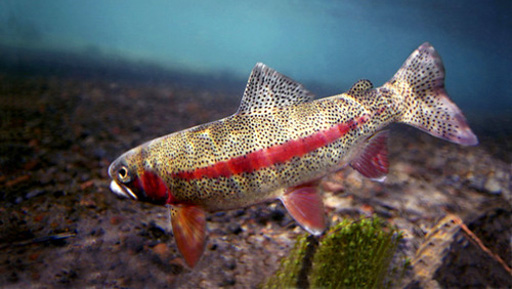
This past summer, an ecologist named Erik Beever sent me a new paper he’d published on a class of critters you might call charismatic invaders: introduced species that are at once ecologically disastrous and deeply beloved. Erik and his coauthors offered a few examples, some you’ve heard of — like wild horses — and some that perhaps you haven’t. If you knew, for instance, that non-native ring-necked parakeets have been known to peck Belgian bats to death, well, you probably have more vivid nightmares than me.
I took a special, proprietary interest in one of Erik’s charming invader groups: introduced salmon and trout. Non-native salmonids have furnished some of my happiest memories. Driving through Utah more than a decade ago, I stopped at a Forest Service ranger station staffed by an elderly volunteer who was appalled to learn that I’d grown up an ignoble bait fisherman rather than an urbane fly angler. He insisted on taking me fly-fishing the next day, a lesson that spawned a lifelong obsession. And, on that fateful, seminal morning, what quarry sucked down the elk-hair caddis that I clumsily chucked at its hole? A European brown trout, Salmo trutta, imported to the desert in a fit of aquatic settler-colonialism.
We anglers have an inflated sense of our environmental self-worth: Fishermen, after all, pushed for the Clean Water Act, and our license fees still prop up state wildlife agencies. But we’re also the world’s most shameless invasive species apologists. It was anglers, or at least their surrogates, who plopped Pacific salmon in the Great Lakes, eastern brook trout in Yellowstone, browns in Patagonia, and rainbow trout, well, pretty much everywhere. We carpet-bomb alpine lakes with fingerlings, pushing out native amphibians in the process. Recreation, time and again, has trumped ecology. Stocking the Sierra Nevada, argued John Muir, would “become the means of drawing thousands of visitors into the mountains… Trout-fishing regarded as bait for catching men, for the saving of both body and soul, is important, and deserves all the expense and care bestowed upon it.”
Muir was inadvertently describing what Erik Beever, in his paper, terms a “social-ecological mismatch” — a situation in which societal priorities contravene environmental ones. Most invasive species, of course, don’t have constituents: As far as I know, there’s no organization devoted to promoting the zebra mussel, which makes it pretty easy to convince people to, say, clean the hulls of their boats. Introduced salmon and trout, on the other hand, are the widely adored bulwarks of a multi-billion-dollar recreational angling industry. Our prejudicial affinity for sportfish blinds us to sound conservation. In New Zealand, Australia, and South America, for instance, brown trout benefit from greater protections than do native galaxiids, a group of fishes whose dreary common names — whitebait, spotted minnow, mudfish — hint at just how little they’re valued.
All this makes things pretty darn tough for the ecologically sensitive angler. American streams are dominated today by rainbow trout, Pacific Rim natives that have been so thoroughly domesticated, manipulated, and propagated by fish hatcheries they’ve been deemed “entirely synthetic.” They’re also, admittedly, a hell of a lot of fun to catch: hard-fighting on the line, gorgeous in the net, delicious on the plate. I’ve caught them in New York, Colorado, Montana, Massachusetts, and a half-dozen other states where they don’t belong. And every time I do, I feel a twinge of guilt for my complicity in the Salmonid Industrial Complex. Not enough of a twinge, granted, that I ever stop fishing.
Escaping the weight of that guilt has been one of the best things about moving to eastern Washington. Here in the Inland Northwest, we’re blessed with endemic redband rainbow trout, a unique and cherished subspecies whose flanks are painted with a vivid sunset blush. Rainbows aren’t just native to the Spokane River, they’re special — the resource that, more than any other, has catalyzed the river’s revival from untreated sewage canal and sacrificial PCB dumping grounds to something vaguely resembling a healthy watercourse. Rather than incurring a social-ecological mismatch, in other words, Spokane’s rainbow trout are agents of alignment, ensuring that environmental priorities — a clean(ish) river — cohere with the desires of anglers.
In a way, of course, this is all a bit of a cop-out. Rather than actually grappling with the ways in which my beloved trout damage aquatic ecosystems, I’ve simply moved to a place that allows me to recast my angling compulsion as ecologically beneficent. I’m nothing if not weak-willed. Still, it’s a curious joy to catch fish where they belong, to slip your hand beneath rose-hued evolutionary perfection in a river that smells only faintly of human feces, and realize you’ve arrived at that rarest of confluences — a social-ecological match.
Photo: Interior redband rainbow trout, U.S. Fish & Wildlife Service
Appreciate your candor! All of us have the same dilemma. What we do for fun often has enormous ecological impact but most (including me) are less honest about it than you.
As a form of solace, read:
https://lithub.com/letter-to-a-young-climate-activist-on-the-first-day-of-the-new-decade/